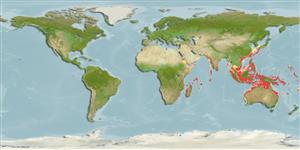>
Eupercaria/misc (Various families in series Eupercaria) >
Labridae (Wrasses)
Etymology: Leptojulis: Greek, leptos = thin + Greek, ioulis, a fish dealing with genera Coris or Thalassoma (Ref. 45335).
More on author: Bleeker.
Environment: milieu / climate zone / depth range / distribution range
Ökologie
seewasser riff-verbunden; tiefenbereich 4 - 75 m (Ref. 90102). Tropical
Indo-West Pacific: Gulf of Oman to the Philippines and Australia.
Size / Gewicht / Alter
Maturity: Lm ? range ? - ? cm
Max length : 13.0 cm TL Männchen/unbestimmt; (Ref. 2334)
Rückenflossenstacheln (insgesamt) : 9; Rückenflossenweichstrahlen (insgesamt) : 11; Afterflossenstacheln: 3; Afterflossenweichstrahlen: 11 - 12. Slender species, usually with brown or dusky mid-lateral stripe. Male with reflective blue spot in the dark band, just past pectoral fin (Ref. 48636).
Found in clear coastal slopes to outer reef lagoons on open rubble patches or rocky bottom (Ref. 48636). Occurs in groups (mostly females) on or near reefs, usually where the water is somewhat turbid and rich in plankton. Fish in the initial phase are much more abundant than the terminal males. Feeds on zooplankton at least a meter above the substrate.
Life cycle and mating behavior
Geschlechtsreife | Fortpflanzung | Ablaichen | Eier | Fecundity | Larven
Oviparous, distinct pairing during breeding (Ref. 205).
Randall, J.E., 1996. Second revision of the labrid fish genus Leptojulis, with descriptions of two new species. Indo-Pac. Fish. (24):20 p. (Ref. 12420)
IUCN Rote Liste Status (Ref. 130435: Version 2024-1)
Bedrohung für Menschen
Harmless
Nutzung durch Menschen
Fischereien: weniger kommerziell; Aquarium: Kommerziell
Tools
Zusatzinformationen
Download XML
Internet Quellen
Estimates based on models
Preferred temperature (Ref.
123201): 24.3 - 29, mean 28 °C (based on 1360 cells).
Phylogenetic diversity index (Ref.
82804): PD
50 = 0.5312 [Uniqueness, from 0.5 = low to 2.0 = high].
Bayesian length-weight: a=0.00977 (0.00470 - 0.02030), b=3.07 (2.90 - 3.24), in cm total length, based on LWR estimates for this (Sub)family-body shape (Ref.
93245).
Trophic level (Ref.
69278): 3.4 ±0.45 se; based on food items.
Widerstandsfähigkeit (Ref.
120179): hoch, Verdopplung der Population dauert weniger als 15 Monate. (Preliminary K or Fecundity.).
Fishing Vulnerability (Ref.
59153): Low vulnerability (10 of 100).
Nutrients (Ref.
124155): Calcium = 94.5 [55.1, 175.1] mg/100g; Iron = 0.878 [0.502, 1.658] mg/100g; Protein = 18.2 [15.3, 20.4] %; Omega3 = 0.172 [0.102, 0.286] g/100g; Selenium = 27.1 [15.1, 52.2] μg/100g; VitaminA = 222 [67, 805] μg/100g; Zinc = 1.66 [1.11, 2.61] mg/100g (wet weight);
